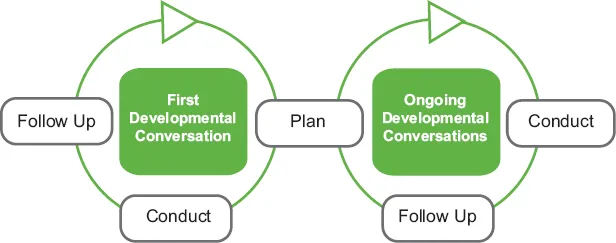
eBook - ePub
Becoming a Leader-Coach: A Step-By-Step Guide to Developing Your People
Naude', Plessier
This is a test
Share book
- 32 pages
- English
- ePUB (mobile friendly)
- Available on iOS & Android
eBook - ePub
Becoming a Leader-Coach: A Step-By-Step Guide to Developing Your People
Naude', Plessier
Book details
Book preview
Table of contents
Citations
About This Book
As a leader, you have different roles to play with your direct reports. One of them is to manage their day-to-day performance. Another is to support their development so they can continue to deliver top performance. Most leaders are comfortable with and effective in the first role. However, many leaders are less clear about the role of developing their direct reports, particularly coaching for development. This guidebook provides an introduction to leader-coaching, including a structure and a set of guidelines to conduct effective formal and informal coaching conversations with your direct reports.
Frequently asked questions
How do I cancel my subscription?
Can/how do I download books?
At the moment all of our mobile-responsive ePub books are available to download via the app. Most of our PDFs are also available to download and we're working on making the final remaining ones downloadable now. Learn more here.
What is the difference between the pricing plans?
Both plans give you full access to the library and all of Perlego’s features. The only differences are the price and subscription period: With the annual plan you’ll save around 30% compared to 12 months on the monthly plan.
What is Perlego?
We are an online textbook subscription service, where you can get access to an entire online library for less than the price of a single book per month. With over 1 million books across 1000+ topics, we’ve got you covered! Learn more here.
Do you support text-to-speech?
Look out for the read-aloud symbol on your next book to see if you can listen to it. The read-aloud tool reads text aloud for you, highlighting the text as it is being read. You can pause it, speed it up and slow it down. Learn more here.
Is Becoming a Leader-Coach: A Step-By-Step Guide to Developing Your People an online PDF/ePUB?
Yes, you can access Becoming a Leader-Coach: A Step-By-Step Guide to Developing Your People by Naude', Plessier in PDF and/or ePUB format, as well as other popular books in Business & Leadership. We have over one million books available in our catalogue for you to explore.
Information
The Formal Coaching Process

Coaching is particularly effective when your direct reports have received feedback that triggered an overtly stated desire to change. It could originate from an assessment center, a 360-degree feedback initiative, or a series of formal and informal comments and conversations that uncovered a developmental theme. In such situations you might want to engage in a formal coaching relationship.
A formal coaching relationship involves collaborative discussions centered on a specific behavioral goal or goals; it is best to address no more than two goals at any given time.
The first conversation should be focused on identifying the goal or goals, establishing the frequency and the process of the developmental conversations, and developing an action plan.
The subsequent conversations, of twenty to thirty minutes each every two or three weeks, will be focused on supporting progress toward the goals, troubleshooting obstacles, keeping the momentum going, and discussing accountability for successful implementation of the individual development plan.
Figure 5 illustrates how you could conduct these meetings for maximum effectiveness and propose questions and content for each step.
Figure 5. Conducting the Conversations

In planning for the first developmental conversation, you should:
• review relevant data such as feedback reports and performance reviews to:


• collect ideas and resources—such as mentors or inspirational books—that can guide developmental actions
• develop questions for the direct report using the RACSR model described in Figure 3
• ask the direct report to:



As you conduct the first developmental conversation, remember the general approach to growth and development: providing a balance of assessment, challenge, and support in a trusting relationship oriented toward specific, agreed-upon results.
In the following pages you will find ideas and questions you can use to conduct the first developmental conversation.
Build rapport and give direction and structure
• State the purpose and benefits of the sessions.
• Ask your direct report what his or her expectations are.
• Highlight the desired outcome: a development plan that is actionable and meaningful for both you and the direct report.
• Discuss confidentiality and its limits.
• Discuss which other key stakeholders will be involved in the development process.
• Express genuine interest in the direct report’s development.
Focus the conversation
Ask questions such as:
• What do you think about the feedback you received?
• What surprised you and what was confirmed for you?
• What did you learn?
• What do you want to do with what you learned?
• How can I help you?
Agree on goals for development
Ask questions such as:
• What themes do you see that relate to your job today and in the future?
• What developmental goals do you want to set?
• What would it look like to achieve those goals? What would I see or hear that would convince me that the goal has been met?
• What makes this goal S.M.A.R.T. (Specific, Measurable, Achievable, Relevant, and Time-bound)?
Also:
• Share your views on how relevant the goals are for you as a manager.
• Explore the direct report’s current priorities and main tasks and how the attainment of the developmental goals will support the direct report in meeting those priorities and main tasks.
• Agree on goals, performance indicators, and a timeline for the goals. Ask the direct report to document them.
Develop an action plan
• Encourage the direct report to think creatively and to try new behaviors.
• Use the questions liste...